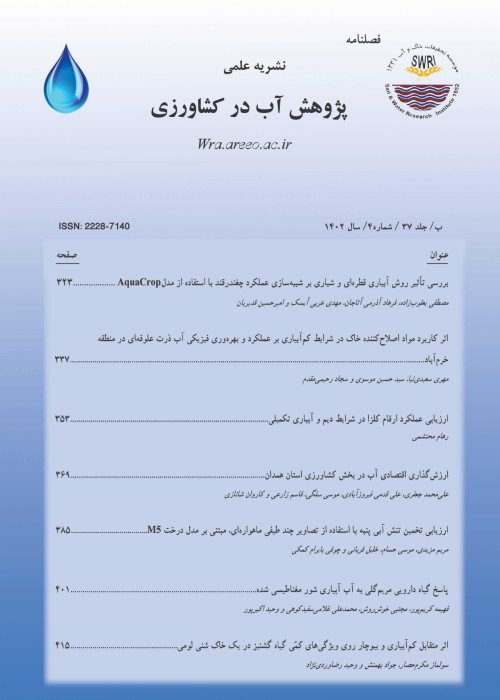Evaluation of HYDRUS_2D Software in Simulating Dry Drainage
Author(s):
Article Type:
Research/Original Article (دارای رتبه معتبر)
Abstract:
There is threat of salinizing for irrigated area in arid and semi-arid areas. Agriculture sustainability under this condition is dependent on removal of excess salt from the root zone. Although conventional drainage systems could provide suitable condition for root zone growth by removing excess water and salt, these systems face some challenges such as high initial capital, environmental problems, high volume and low quality of drained water at outlet. Alternative systems or their combination with conventional ones may be good solution for these problems. In this study, dry drainage (DD) was conducted as environmental and economical alternative technique. This research was carried out to evaluate DD and calibrate HYDRUS-2D model, in July, 2015, at Aburaihan Faculty, University of Tehran. Necessary data was collected from lysimeters in research field of irrigation and drainage Eng. Department to calibrate the model and investigate DD. Treatments were carried out in four lysimeters with dimension of 1×1×1 m and included two ratios of cultivated to uncultivated width strip (1(cultivated):1(uncultivated); and 2:1) and two levels of irrigation water salinity (1.5 and 3 dS m-1). Shallow water table was at 90 cm and study was continued for 70 days. Results showed that salt moving direction was from the irrigated to the bare evaporation strips at all treatments, and final soil salinity of uncultivated was much more than the cultivated area. Also, increasing cultivated to uncultivated width (from 1:1 to 2:1) could transport soil salinity from the irrigated to evaporation strip, but it couldnt stabilize salinity of the root zone. Final salinity of root zone in treatments with ratio of 1:1 was not more than 6 dS m-1 (1.7 to 2.7 times of initial soil salinity).Thus, for the other two treatments, the final salinity was more than 14 dS/m (4.9 to 7.7 times the initial soil salinity). Results of modeling and statistical indexes showed that HYDRUS_2D could simulate water flow and salinity transport well in lysimetric DD. SE and NRMSE for simulated soil moisture were between 7% to 11 percent and 0.021 to 0.057 cm3 cm-3,respectively, and these values for simulated soil salinity were between 24% to 29 percent and 2.01 to 2.73 dS m-1, respectively. Based on statistical indicators, HYDRUS_2D simulated soil moisture better than soil salinity.
Keywords:
Language:
Persian
Published:
Journal of Water Research in Agriculture, Volume:31 Issue: 4, 2018
Pages:
595 to 607
magiran.com/p1798602
دانلود و مطالعه متن این مقاله با یکی از روشهای زیر امکان پذیر است:
اشتراک شخصی
با عضویت و پرداخت آنلاین حق اشتراک یکساله به مبلغ 1,390,000ريال میتوانید 70 عنوان مطلب دانلود کنید!
اشتراک سازمانی
به کتابخانه دانشگاه یا محل کار خود پیشنهاد کنید تا اشتراک سازمانی این پایگاه را برای دسترسی نامحدود همه کاربران به متن مطالب تهیه نمایند!
توجه!
- حق عضویت دریافتی صرف حمایت از نشریات عضو و نگهداری، تکمیل و توسعه مگیران میشود.
- پرداخت حق اشتراک و دانلود مقالات اجازه بازنشر آن در سایر رسانههای چاپی و دیجیتال را به کاربر نمیدهد.
In order to view content subscription is required
Personal subscription
Subscribe magiran.com for 70 € euros via PayPal and download 70 articles during a year.
Organization subscription
Please contact us to subscribe your university or library for unlimited access!


